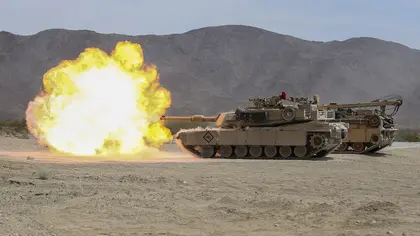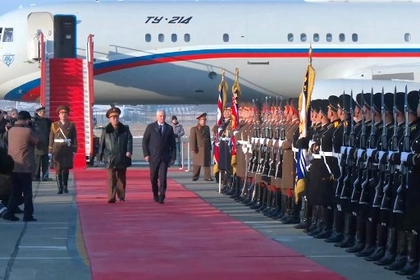“This is very bad news,” Kremlin spokesman Dmitry Peskov said on Thursday in response to a US announcement that it would sending depleted uranium tank rounds to Ukraine.
The Russian embassy went one step further and said it was a “a clear sign of inhumanity” and the US is “deeply indifferent to both the present of Ukraine and the future of the republic and its European neighbors.”
- See the most contemporary Ukraine news reports for today.
- Look at the latest Ukraine news that was released today.
JOIN US ON TELEGRAM
Follow our coverage of the war on the @Kyivpost_official.
Of course, what the Kremlin is really concerned about is that once they arrive, Ukraine’s armed forces will be able to take out even more of Moscow’s tanks
Unfortunately for Russia, it’s not just the American M1 Abrams and the British Challenger 2 tanks that will go into the fight against the Russian army on a Ukrainian battlefield, armed with controversial depleted uranium (DU) armor-piercing shells.
London in May and Washington in September confirmed Kyiv would be sent main battle tanks with the best anti-tank ammunition possible. Both the US and British armies view the 120mm tank main gun round, flying at velocities roughly twice the speed of a bullet from an average rifle, and containing a depleted uranium dart capable of punching through two meters of steel armor, by far the most effective direct fire weapon in their arsenals.
Although the depleted uranium in the munition is, in fact, less radioactive than uranium found in nature, pro-Russia information platforms have pushed the narrative DU-armed Abrams and Challenger tanks amount to intentional exposure of millions of Ukrainian civilians to deadly radioactivity, and a war crime a peace-loving state like Russia would never commit.

British Defence Intelligence Update Ukraine 23 December 2024
Ukraine’s allies have nonetheless vowed to go on with the DU tank ammo deliveries, with Britain confirming in June and the US in September the Armed Forces of Ukraine (AFU) will get the munitions.
A reported 14 Challenger 2 tanks arrived in Ukraine in May and were first sent into combat in late August. It’s not clear if or when they got DU ammunition. The first ten of a reported 31 Abrams tanks will reach Ukraine in September, according to news reports.
The first DU-capable western tank to reach Ukraine was almost certainly not the British Challenger 2, but a Slovenian tank called a M-55S. Liubljana heavily upgraded 28 Soviet-era T-55 tanks during the 2000s, among other modifications rearming the vehicle with a NATO-standard 105mm cannon.
Slovenia announced it would send its M-55S tanks to Ukraine in Oct. 2022. The first batch arrived in Ukraine in December.
In June Belgium allocated €32 million ($34 million) to send 105mm depleted uranium anti-tank shells, along with 40 to 50 armored personnel carriers, to Ukraine. A NATO member and one of the alliance’s leading arms manufacturers, Belgium produces the same 105mm DU anti-tank shell as any other NATO weapons producer, a munition called STANAG 4458. That 105mm shell is, by NATO designs and standards, fully compatible with the 105mm cannon aboard the T-55S.
According to Russian military information platforms, Ukraine’s 67th Mechanized Brigade has operated the M-55S tank since May and on the fighting line since at least July, and possibly since June. Neither side has reported or even claimed a M-55S has fired even a single DU round.
However, the fact remains: The DU-capable M-55S tank has been in country since early 2023, and the AFU has had access to DU anti-tank shells usable by that tank since early-to-mid summer, at minimum two months before Britain’s Challenger 2 tank (with or without DU aboard) first saw (limited) action in Ukraine.
But in terms of raw quantities of DU-cored rounds potentially aboard, no other weapons system in the Russo-Ukraine war is capable of carrying more ammunition containing depleted uranium than the US-delivered Bradley M3 infantry fighting vehicle.
A tracked armored personnel carrier looking somewhat like a tank but more lightly armored and armed with a fast-firing 25mm automatic cannon, the Bradley even in the 1980s carried shells with a depleted uranium armor-piercing rod inside it roughly the size of a crayon, as part of its standard ammo load out.
Called the M919, the DU-core 25mm anti-tank cannon shell saw its first major field use during the US-led coalition war against Iraq called Desert Storm in 1991. The at-the-time secret DU projectile proved devastating against Iraqi armor and often able to punch through even the thick frontal armor of Soviet-manufactured T-72 tanks designed, specifically, to be impervious to light cannon like the Bradley’s 25mm gun.
Anti-tank shells aboard western tanks like Abrams and Challenger use the same basic technology but on a more massive scale. The dart-like DU rod inside a NATO-standard 105mm or 120mm shell is approximately as thick as a finger and as long as a bowling pin.
Currently, the US military maintains in stock two 25mm armor-piercing rounds for the Bradley, one with DU called an M919, and an older round with a tungsten core, which the M919 mostly replaced, called the M791. In January following announcement of Washington’s intention to transfer Bradley infantry fighting vehicles to Ukraine, US officials refused to say whether they would send Ukraine tungsten-core M791 armor-piercing round, or uranium-core M919 rounds.
Combat vehicle ammunition load out is a military secret in Ukraine. US Army doctrine and standard practice calls for a Bradley to carry 70 M919 DU shells in one of vehicle’s two 25mm ammunition boxes, and 230 high explosive shells carried in the other ammunition box.
The AFU’s 47th Mechanized Brigade is widely reported to be the sole unit operating M3 Bradley infantry fighting vehicles. Their first commitment to combat, in early June, was mostly a failure, with the 47th launched into frontal attacks against Russian fortifications in the southern Orikhiv sector.
Over two weeks of fighting the formation reportedly saw up to 30 Bradleys knocked out – from an estimated 90 to 110 available – to Russian minefields, missile ambushes and helicopter assaults.
According to soldier accounts and independent Ukrainian news media reports, in those battles the 47th’s Bradley operators practically never fired 25mm anti-armor ammunition, because none of the Russian weapons attacking them were armored vehicles.
Open-source video of Bradleys operating in Ukraine generally show the AFU using the vehicle to hit Russian infantry positions, or suspected positions, with automatic HE suppressive fire.
While the mere words “depleted uranium” may sound scary because of the association with nuclear weapons and power plants, and might be used in fear-mongering propaganda, this much studied element is not a threat to human health.
Depleted uranium is purified to contain only the U-238 isotope (half-life 4.5 billion years), removing the more radioactive U-235 used in nuclear weapons (half-life only 159,000 years). So, it is depleted of the more dangerous and fissionable form of the element.
DU is appreciably less radioactive – usually around 40 per cent less - than unprocessed uranium. Humans are constantly exposed to the unprocessed form, including in drinking water. While depleted uranium is still slightly radioactive, it only emits alpha particle radiation, which is not powerful enough to penetrate human skin. Just being around depleted uranium is not a danger to human health.
Uranium has the highest atomic weight of the primordially occurring elements, i.e., present since the formation of the Earth, and its density is about 70 percent higher than that of lead and slightly lower than tungsten.
Thanks to this extreme density, depleted uranium shells have a much higher armor piercing capacity than previous anti-tank ammunition.
You can also highlight the text and press Ctrl + Enter






